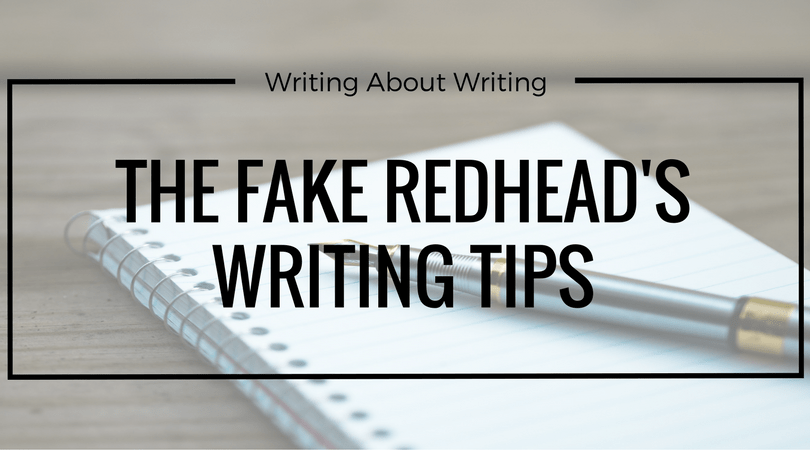Writing Tips | Find Your Next Favorite Book | Prompt Library | Shop The eBooks
Your Novel’s Setting
The setting in your novel is just like one of your cast of characters—it has an appearance, a personality, quirks, places to hide the figurative dirty laundry, the whole nine yards—so it’s important to take as much care with introducing it as you would your protagonist (or any of your other characters. Obviously.)
In my second writing tip, I kicked things off with a ridiculous and hyperbolic introduction of a hypothetical main character. Don’t remember? Have a read and come on back. I can wait.
Now, imagine cracking open a book, and after you read THAT, you read five pages of exposition about every single detail of where your character is, down to the size (in inches) of the television in the room where your character is eating their breakfast.
Unless the television has a crack through the middle that makes the picture go all wonky, or it’s mounted on the wall at a weird angle, the reader doesn’t need to know about how big it is or where it’s placed within the room.
I say this a lot-because I want to hammer the point home-but as you introduce your characters and setting and everything else that sets up your story, your goal is to minimize instances where your potential reader is going to get turned off and want to stop reading.
They want to get to the meat of the plot as badly as you want to write it.
So click the Continue Reading button for three (and a half) tips on how to introduce your novel’s setting.
1 Don’t Describe Everything At Once
Ease into it.
Go macro before you go micro.
Build the house’s foundations before you start designing the living room. Okay, so I’m going to stop right there, and also maybe stop watching House Hunters: Renovation marathons while I draft my blog posts (okay, maybe I’ll just hold off until I finish season one of The Catch. Not my favorite show in the world, but holy crap the wardrobe!)
Anyway, let’s use the example of me describing my alma mater—purely because I sent some friends directions to the beach volleyball facility the morning I drafted this post (featuring the most convenient place on campus to park and where to go for emergency caffeine).
To anyone who doesn’t know anything about the University of Arizona campus—located in beautiful Tucson—the first thing I’d say, mostly because it’s the biggest thing I remember from my first campus tour, is that the builders prided themselves on the fact that all the campus buildings have red brick facades.
There’s the image you start with: a campus with buildings made of red bricks.
Then you can sprinkle a couple references to the palm trees, because this IS the desert and that imagery changes it from a campus of red brick buildings that you would find back east.
Maybe next you talk about the mall—no, not a literal on-campus shopping center, think something along the lines of the national one in D.C.—and how it cuts through the middle of campus from the east side of Old Main to the intersection of University and Campbell.
Next, go deeper and talk about how-depending on the time of year-the grass is either nice and green, or dead.
Then you can go even MORE specific.
The library: the only building that’s NOT brick, because the builders wanted the building to stand out as a welcoming beacon amongst the rest of the campus facilities*
Bike paths: walk at your own risk.
The McKale Center: Where I spent a bulk of my four years when I was in college. I could write a book on that building, but it would A) take forever and B) I have WAY too many stories that I can’t tell because of reasons. I will say that the renovations (which, of course happened AFTER I graduated) are freaking fantastic and it’s one of the most difficult courts to win on in college basketball for a reason. Cochise: the dorm I lived in my freshman year, featuring urinals in the ladies bathrooms and some heinous green carpets. And for those of you who have seen the first Revenge Of The Nerds movie, yes, that was filmed at the U of A, and yes, Cochise is the dorm that the characters lived in.
The movie theater in the Student Union: not really worth the effort. Find a friend with a car or take a Lyft to the El Con mall if you need a break from campus to watch a movie when it actually comes out.
Military vehicle flyovers: the Davis-Montham Air Force Base is about 10 miles away, so hearing the sound of military aircraft is basically a given. Also, the aircraft boneyard is down there, and that is one of the coolest things I’ve ever seen.
So that’s my point on that. When you’re introducing a place like a city or a college campus, you can start by describing the basics before you go to the specific.
Now, let’s move on to a point I’m going to call Point 1A
1A You Don’t Have To Describe Everything
In Point 1, I described a handful of places on the University of Arizona campus, but I didn’t describe all of them—like the Robson Tennis Center, Bear Down Gym, the Park Student Union, the dance building, etc.—because it’s not entirely necessary.
Why not?
Because A, it’s fine to leave some things to your readers’ imaginations, and B, because not describing certain locations can be a device that helps you advance your plot.
And because it’s all about me (hey, I’m the one writing these posts, I do what I want), let’s use the #WhoIsTalyaNightingale universe as an example.
When Talya accidentally ends up in the town that the bulk of the story takes place in, it’s initially described very simply: there’s a lake on one side, the town on the other, and forest pretty much everywhere else.
That’s it!
That’s the first introduction to Phoenix Springs.
And that’s fine.
Here’s another example: there’s a house in the book where a number of pivotal events take place.
(Actually, there are a couple houses in the book where important things happen, but anyway, back to the point.)
In the story, I make it clear that the house in question is large and full of secrets, and that’s why I also make it a point to only have Talya explore a fraction of it. That way, it’s something that I can continue to unpack in future stories.
As for the other house in the book—the one Talya lives in—is it really necessary for me to describe the fine details of the guest room she’s not going to spend all that much time in? The specific configuration of the downstairs bathroom?
My point: bathrooms are implied.
Unless they’re a designated ladies room with urinals, because that’s something that’s unique to that place.
Also, if the dwelling you’re describing DOESN’T have a bathrooms, that’s definitely something you can go ahead and mention.
2 Pick A Few Locations To Center Your Plot Around
Don’t overwhelm your readers. Especially if you’re writing fantasy and/or the type of book that comes with a map.
(On that note, I should probably get a map in the works for the #WhoIsTalyaNightingale universe when I get to the point where I’m going to expand it. I’ll get to it. It’s not going to be relevant for a while, so don’t worry about it.)
Anyway.
Let’s look at Friends.
You’ve got an apartment the characters definitely can’t afford in New York City in real life, another apartment the characters probably can’t afford in New York City in real life, and a coffee shop.
Simple.
Not overwhelming.
In the Lord of the Rings trilogy, you don’t really get all-in on places like Mordor or Gondor or Rohan until the latter books.
In the #WhoIsTalyaNightingale universe, you’ve got the houses I mentioned in 1A, a lake, and a bar that really make up a bulk of the major settings.
3 You Don’t Have To Be Specific About Every Place Your Character Goes
Talya Nightingale gets into a lot of fights.
It’s not that her character was written as belligerent (except when she is, because reasons), but due to specific circumstances that include a missing superhero team and a weird monster infestation, Talya if forced into a lot of situations she has to fight her way out of.
And she fights in a lot of difference places around town.
But you don’t need to describe each place in detail. It takes away form the plot and the action—which is fighting.
And fighting is a lot more entertaining than reading an entire page detailing the specifics, I don’t know, of a dog park.
It’s like in the Mighty Morphin Power Rangers (in case you’re rusty, those are the episodes that aired in the 90s that the new movie is based on). The Rangers ended up fighting in a few core places. The park. The lake. The park at the lake. A ubiquitous office park. The conveniently-placed rock quarry where they could do lot of fun flips whenever they jumped off cliffs and had those fun colorful explosions.
But they rarely ever fought at school, because for some reason Rita Repulsa (and later, the thing of my childhood nightmares, Lord Zedd) respected the Rangers’ need to have a solid high school education.
I don’t know.
You don’t see a lot of details in many of these extraneous places, because like I said earlier, you just want to get to the plot.
Check Out The Last Writing Tip Check Out The Next Writing Tip
Shop The eBooks | Find Your Next Favorite Book
Want more prompts? Check out the Prompt Library.
*Don’t know how well that worked, since I only set foot in the library twice, and both times were my senior year, but whatever. It is a nice facility. I just had other places where I pretended to study
Do you have a question about writing that you want me to answer? Leave a comment below! (I’m also answering questions in the Facebook group. Hop on over and say hi!)






